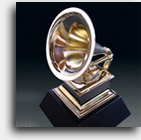I have several acquaintances who have won Grammys in recent years in the New Age category. I wrote a music marketing piece about the February 2015 win of two of them on this blog, Ricky Kej and Wouter Kellerman. I am also friends with two local Seattle area musicians, Eric Tingstad and Nancy Rumbel, who received a Grammy for Best New Age Album in 2003. Although I myself am not a New Age musician, New Age music and its Grammy category intrigue me both as a listener and as a music marketer.
I discovered the band White Sun about a year ago when I received a private Facebook link to their debut self-titled album during the first round of the Grammy listening and voting process in fall 2015. Their album entry really stood out. I was very impressed with their music, most especially with their female lead vocalist and unusual lyrics. As a vocalist and lyricist myself I listen closely to vocals and lyrics. The lyrics of White Sun’s songs are all non-English yogic mantras set to addictive repetitive melodies. From a production perspective, Garujas’ vocals are both immaculately produced and prominently front and center, which I also appreciate. The instrumental music production is quite lush and complex, much like a modern movie score, with the organic twist of traditional East Indian instruments.
In addition, the visual marketing of White Sun’s second album is striking to me. I’ve included some of their images in this post. The story of the mandala on the cover of the album can be found on their website.
The New Age category interests me as a music marketer, since, along with the Children’s Music Album category, New Age usually has many fewer entries than Pop, Rock or American Roots. It also has virtually no big label artist winners, and most are extremely hard working indie musicians doing their own marketing and promotion both inside and outside the Grammy process.
After I heard their music last year, I knew White Sun would have a good chance at Grammy nomination this year, and indeed, they have been nominated this year in the Best New Age Album category. I was so certain they would be nominated, that, as I did with Ricky and Wouter, I asked for an interview before the nominations were announced.
In my study so far of the marketing process for indie artists, I have come to the conclusion that it takes four important elements for a relatively unknown indie artist like White Sun to receive a Grammy win:


